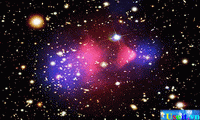Login form
Galaxies
 Galaxy, a massive ensemble of hundreds of millions of stars, all gravitationally interacting, and orbiting about a common center. Astronomers estimate that there are about 125 billion galaxies in the universe. All the stars visible to the unaided eye from Earth belong to EarthÔÇÖs galaxy, the Milky Way. The Sun, with its associated planets, is just one star in this galaxy. Besides stars and planets, galaxies contain clusters of stars; atomic hydrogen gas; molecular hydrogen; complex molecules composed of hydrogen, nitrogen, carbon, and silicon, among others; and cosmic rays.
Galaxy, a massive ensemble of hundreds of millions of stars, all gravitationally interacting, and orbiting about a common center. Astronomers estimate that there are about 125 billion galaxies in the universe. All the stars visible to the unaided eye from Earth belong to EarthÔÇÖs galaxy, the Milky Way. The Sun, with its associated planets, is just one star in this galaxy. Besides stars and planets, galaxies contain clusters of stars; atomic hydrogen gas; molecular hydrogen; complex molecules composed of hydrogen, nitrogen, carbon, and silicon, among others; and cosmic rays.
Origins of Galaxies:
As the 21st century began, astronomers believed they were much closer to understanding the origins of galaxies.
Observations made by the Cosmic Background Explorer (COBE) satellite, which was launched in 1989, confirmed predictions made by the big bang theory of the universeÔÇÖs origin. COBE also detected small irregularities, or ripples, in the background radiation that uniformly pervades the universe. These ripples were thought to be clumps of matter that 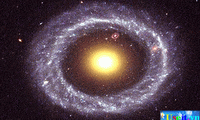 formed soon after the big bang. The clumps became the seeds from which galaxies and clusters of galaxies developed. The ripples were studied in more detail in limited regions of the sky by a variety of ground-based and balloon-based experiments. A more recent spacecraft, NASAÔÇÖs Wilkinson Microwave Anisotropy Probe (WMAP), made even more accurate observations of these ripples across the entire sky. In 2003 WMAPÔÇÖs results confirmed the existence of these galactic seeds, providing a full-sky map of the universeÔÇÖs emerging galaxies.
formed soon after the big bang. The clumps became the seeds from which galaxies and clusters of galaxies developed. The ripples were studied in more detail in limited regions of the sky by a variety of ground-based and balloon-based experiments. A more recent spacecraft, NASAÔÇÖs Wilkinson Microwave Anisotropy Probe (WMAP), made even more accurate observations of these ripples across the entire sky. In 2003 WMAPÔÇÖs results confirmed the existence of these galactic seeds, providing a full-sky map of the universeÔÇÖs emerging galaxies.
Classification of Galaxies:
When viewed or photographed with a large telescope, only the nearest galaxies exhibit individual stars. For most galaxies, only the combined light of all the stars is detected. Galaxies exhibit a variety of forms. Some have an overall globular shape, with a bright nucleus. Such galaxies, called ellipticals, contain a population of old stars, usually with little apparent gas or dust, and few newly formed stars. Elliptical galaxies come in a vast range of sizes, from giant to dwarf.In contrast, spiral galaxies are flattened disk systems containing not only some old stars but also large populations of young stars, much gas and dust, and molecular clouds that are the birthplace of stars . Often the regions containing bright young stars and gas clouds are arranged in long spiral arms that can be observed to wind around the galaxy. 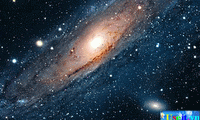
Generally a halo of faint older stars surrounds the disk; a smaller nuclear bulge often exists, emitting two jets of energetic matter in opposite directions.Other disklike galaxies, with no overall spiral form, are classified as irregulars. These galaxies also have large amounts of gas, dust, and young stars, but no arrangement of a spiral form. They are usually located near larger galaxies, and their appearance is probably the result of a tidal encounter with the more massive galaxy.
Some extremely peculiar galaxies are located in close groups of two or three, and their tidal interactions have caused distortions of spiral arms, producing warped disks and long streamer tails. Ring galaxies, for example, form when a small galaxy collides with the center of a spiral galaxy. An intense ring of stars forms at the outer edges of the new, combined galaxy. The Hubble Space Telescope (HST) has revealed many more ring galaxies than astronomers expected, suggesting that galactic collisions may be common.Quasars are objects that appear stellar or almost stellar, but their enormous redshifts identify them as objects at very large distances (see Quasar; Radio Astronomy). They are probably closely related to radio galaxies and to BL Lacertae objects. The Hubble Space Telescope (HST) completed a survey of nearby galaxies in 1996 that revealed that all large galaxies may be homes to quasars early in the galaxyÔÇÖs life. The HST survey showed that most of the galaxies contain massive black holes, which may be the next stage in galactic evolution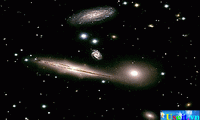 .
.
Some popular Galaxies:
Hickson Compact Group (HCG) 87: is about 400 million light-years from Earth. The galaxies are interacting gravitationally, influencing one anotherÔÇÖs structure and evolution. The image was taken by the Gemini South telescope at Cerro Pach├│n, Chile.
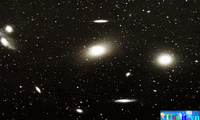 The elliptical galaxies M86 (center) and M84 (right): are members of the Virgo cluster of galaxies, located about 50 million light-years away from our smaller cluster, the Local Group. Elliptical galaxies are populated by older stars and contain little interstellar matter. They are usually the brightest galaxies.
The elliptical galaxies M86 (center) and M84 (right): are members of the Virgo cluster of galaxies, located about 50 million light-years away from our smaller cluster, the Local Group. Elliptical galaxies are populated by older stars and contain little interstellar matter. They are usually the brightest galaxies.
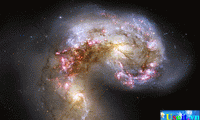 Colliding Galaxies: a collision between two spiral galaxies that began millions of years ago created the so-called Antennae galaxies, named for the antenna-like arms thrown out by the encounter. The two galaxies are merging together, causing billions of new stars to form.
Colliding Galaxies: a collision between two spiral galaxies that began millions of years ago created the so-called Antennae galaxies, named for the antenna-like arms thrown out by the encounter. The two galaxies are merging together, causing billions of new stars to form.
The spiral galaxy M100: is located between 35 million and 80 million light-years from earth. The Hubble Space Telescope captured this image of the core of M100 after repairs were made to the telescope in December 1993. 
The Andromeda Galaxy, a spiral galaxy similar to our own Milky Way Galaxy, is the farthest object from Earth visible to the naked eye. Its whirlpool of stars can be seen from the Northern Hemisphere in the constellation Andromeda. The Milky Way and Andromeda galaxies are part of a group of galaxies called the Local Group, which in turn is part of larger group called the Virgo Cluster.
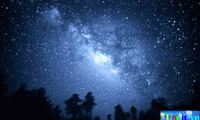 Milky Way : Spiral galaxies, such as our own Milky Way, have a relatively flat disk shape with spiral arms. This false-color image looks toward the center of the Milky Way, located 30,000 light-years away.
Milky Way : Spiral galaxies, such as our own Milky Way, have a relatively flat disk shape with spiral arms. This false-color image looks toward the center of the Milky Way, located 30,000 light-years away.
HoagÔÇÖs Object: A ring of young, massive, blue stars surrounds a nucleus of older, yellow stars in the galaxy known as HoagÔÇÖs Object. Astronomers speculate that this unusual separation is the result of a collision with another galaxy. HoagÔÇÖs Object lies 600 million light-years away in the constellation Serpens.
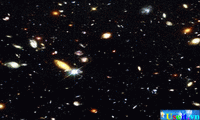 Distant Galaxies: In January 1996 astronomers were able to prove that there are five times more galaxies in the universe than previously thought. Helping them in this conclusion was the Deep Field image taken by the orbiting Hubble Space Telescope. Although the image covers only a tiny speck of the sky, it is packed with galaxies.
Distant Galaxies: In January 1996 astronomers were able to prove that there are five times more galaxies in the universe than previously thought. Helping them in this conclusion was the Deep Field image taken by the orbiting Hubble Space Telescope. Although the image covers only a tiny speck of the sky, it is packed with galaxies.
